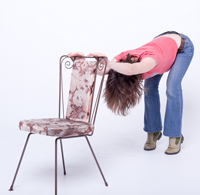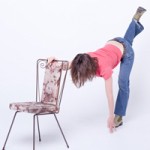by Kara-Leah Grant
For years and years and years this posture has been my nemesis.
I hated it. I sucked at it. It challenged me in every way.
When I first started yoga, back in 1995 at a ten-week Iyengar course, I was so incredibly tight that when we went into a standing forward bend, I couldn’t even reach forward and touch my knees.
I had no forward movement in my pelvis at all – my hamstrings were just way too tight. And that’s the first part of the body that must be freed up for a standing forward bend to happen with ease.
We must be able to hinge through our pelvis. If the pelvis can’t hinge forward, we tend to bend at the waist, which strains the lower back and doesn’t provide any benefits to the body at all.
There’s many ways and means to help our pelvis learn to move, and therefore go into a standing forward bend.
The first is to allow our knees to bend deeply. This releases the hamstrings and makes it easier for the pelvis to tilt. If you have tight hamstrings – it’s the first port of call in forward bends. Bend the knees. Allow the pelvis to find movement. Sometimes walking the heels up and down, or lifting them right up as I am in that photo also helps.
The second way to help our pelvis learn to move is to place the hands on the hips to bring awareness into that area of the body. Where the hands and breath goes, our awareness goes. All the time we took in Mountain Pose in finding the correct alignment of our pelvis starts to pay off here. We already have a greater awareness of this part of the body and can sense how it can tilt forward and back. With the hands on the hips, we can encourage it to tilt forward.
The third way is to keep the sternum lifted and the shoulder blades drawn toward the spine and down toward the tailbone – again, something we spent time developing in Mountain Pose. In fact, it’s incredibly useful to remind ourselves that as we hinge at the hips to bend forward our spine is retaining the alignment of tadasana.
That’s where I start a standing forward bend – playing with the pelvis, finding that forward tilt, bending the legs deeply, lengthening the spine.
Only after there’s free movement through the pelvis and the spine can stay long and open do I even begin to contemplate finding any depth in the posture.
In fact, up to this point, playing with a standing forward bend while using a bench or chair for support in front of you is a wise move. You can rest your hands or arms on the support and focus on lengthening the spine and strengthening the legs.
That strength in the legs is key if you want to find depth in the surrender of the forward bend.
It’s also the aspect of the forward bend that I have only integrated in the last year.
Yes – it’s taken me over a decade of yoga to tune in and realise that I was’t correctly activating my legs in standing forward bends.
Because my legs weren’t activated, they weren’t strong. Because they weren’t strong, my body didn’t feel safe in letting go and surrendering and I was unconsciously gripping around my hips and spine, making it impossible for me to actually bend forward.
Doh!
So this year, my focus in standing forward bends – once my spine and pelvis – has all been in my legs.
This starts in my feet. I often walk my heels up and down, grounding through the balls in my feet over and over… yes, just like the way we did in Tadasana. This ensures that I’m sending the grounding force down through my feet into the ground. With that descending force arises a strength up my legs which supports me and frees my hips.
It’s been incredible to witness from the inside out.
And it’s taken time.
I’ve discovered that I have -or had – a weakness in my right leg and foot. No surprise there. When I was 25, my spine was deteriorating after the apparent initial success of my spinal fusion at age 16. I had constant sciatic pain down my right leg, my foot was half numb and I was walking with a limp. It was like all life force retreated from that leg and foot.
Over the last six months in particular, I have been consciously grounding down the right foot, opening and releasing it into the earth, which then allows energy to rise up the leg and support me.
This doesn’t just happen automatically – not yet anyway – I have to consciously think about it and make it happen every time in a forward bend.
But what a difference.
Suddenly, there is a surrender happening. I have the strength through my legs and hips – in the right way – to let go.
It feels magical.
With bent knees, my belly is melting on to my thighs and my nose is grazing my shins.
I am learning to let go.
Standing forward bend has become a brand new posture, yet again. It’s one of my favourites now, and one I work with daily – whether on my mat or not.
Kitchen benches are the perfect height for releasing into a forward bend, and nothing is more delicious for the body after cooking or washing dishes than just taking the time to breathe it all out.
And this is the beauty of our home practice. It teaches us to take moments in our life to be yoga.
Standing washing dishes, we can play in Tadasana. In the kitchen or at the dining room table, we can take a moment to surrender forward.
It’s our yoga. It’s our life. It’s all one.
Key explorations in Standing Forward Fold:
- Explore movement in the pelvis, tilting forward and back, hands on hips.
- Find length through the spine, keeping the sternum open.
- Walk through the feet, bending the knees and grounding through the balls.
- Don’t be afraid to bend the knees deeply and find a place of surrender.


Once I came to the realization that Tadasana is in every pose, my practice shifted. And yep, sweet surrender followed and what a difference it made. That perfect balance between effort and ease.
Hey Jude,
It’s such a simple, yet profound insight isn’t it?